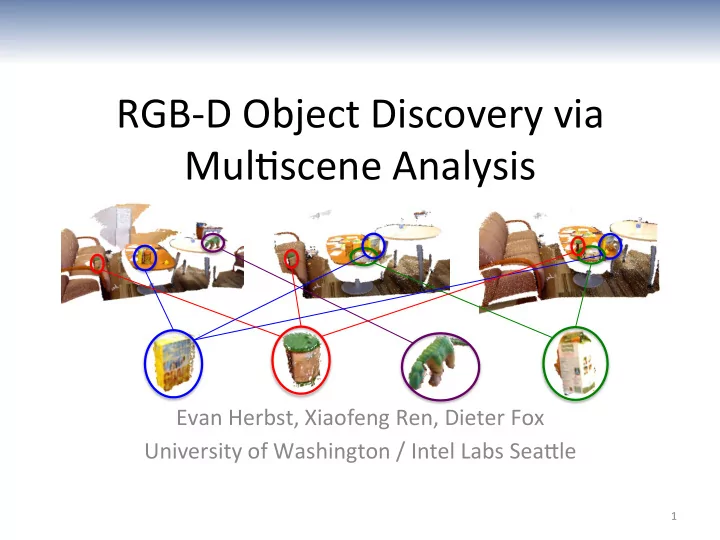

RGB-‑D ¡Object ¡Discovery ¡via ¡ Mul7scene ¡Analysis ¡ Evan ¡Herbst, ¡Xiaofeng ¡Ren, ¡Dieter ¡Fox ¡ University ¡of ¡Washington ¡/ ¡Intel ¡Labs ¡SeaIle ¡ 1 ¡
Problem ¡Descrip7on ¡ • Goal: ¡iden7fy ¡and ¡model ¡objects ¡using ¡change ¡over ¡ 7me ¡ § Handle ¡textureless ¡objects ¡ § Avoid ¡appearance/shape ¡priors ¡ • Represent ¡a ¡loca7on ¡as ¡sta7c ¡+ ¡dynamic ¡parts ¡ 2 ¡
Object ¡Discovery ¡from ¡Range ¡Data ¡ • [Shin ¡et ¡al, ¡ICRA10, ¡RSS10]: ¡ICP ¡ini7alized ¡with ¡local ¡3-‑D ¡ feature ¡matches ¡ • [Ruhnke ¡et ¡al, ¡ICRA09]: ¡2-‑D ¡feature ¡matches ¡in ¡ generated ¡views ¡ • Single ¡scenes ¡ • Focus ¡on ¡detec7ng ¡repe77ve ¡structure, ¡model ¡merging ¡ • No ¡visual ¡informa7on ¡ 3 ¡
Method ¡Overview ¡ 1. SLAM ¡ . ¡. ¡. ¡ 2. Change ¡detec7on ¡ 3. Segmenta7on ¡ [ICRA11] ¡ 4. Similarity ¡ 5. Object ¡discovery ¡ 4 ¡
Two-‑Scene ¡Segmenta7on ¡(ICRA11) ¡ • Pointwise ¡change ¡detec7on ¡ § ¡probabilis7c ¡sensor ¡measurement ¡model ¡ § Incorporate ¡depth, ¡color, ¡surface ¡orienta7on ¡ § Handle ¡occlusion ¡ § View-‑based: ¡accumulate ¡evidence ¡from ¡different ¡viewpoints ¡ • MRF ¡over ¡scene ¡points ¡to ¡reduce ¡noise ¡ • Limita7ons ¡ § Can ¡only ¡make ¡use ¡of ¡two ¡scenes ¡ § No ¡no7on ¡of ¡segment ¡persistence ¡ 5 ¡
Mul7scene ¡Segmenta7on ¡ • Extra ¡scenes ¡provide ¡extra ¡constraints ¡ • MRF ¡to ¡assign ¡change ¡labels ¡wrt ¡all ¡scenes ¡at ¡once ¡ l = ¡< 0,0,1,1 > ¡ ¡ ¡ • Data ¡cost ¡based ¡on ¡change ¡detec7on ¡ # p ( s moved in j ), l j = 0 % ! E D ( s , l ) = $ 1 " p ( s moved in j ), l j = 1 % j & • Smoothness ¡cost: ¡Hamming ¡distance ¡weighted ¡by ¡curvature ¡ 6 ¡
Segmenta7on ¡Results ¡ • Concatenated ¡pairwise ¡MRFs ¡vs. ¡mul7scene ¡MRF ¡ mul7scene ¡MRF ¡ two-‑scene ¡MRFs ¡ ¡ • Over ¡39M ¡points ¡(12 ¡scenes), ¡25% ¡reduc7on ¡in ¡each ¡of ¡ type ¡I/II ¡errors ¡in ¡change ¡detec7on ¡ 7 ¡
Object ¡Discovery ¡ • Output ¡of ¡segmenta7on ¡step: ¡ § Par7al ¡3-‑D ¡models ¡ § Many ¡2-‑D ¡views ¡of ¡each ¡3-‑D ¡segment ¡ • Goal: ¡group ¡these ¡segments ¡by ¡object ¡ 8 ¡
Object ¡Discovery: ¡Spectral ¡Clustering ¡ • Given ¡pairwise ¡similari7es ¡(edge ¡weights ¡in ¡a ¡graph ¡ whose ¡nodes ¡are ¡segments) ¡ [ W ] ij = w ij ¡ i , j ! V , ¡ • Minimize ¡the ¡ normalized ¡cut ¡criterion ¡ # w ij i ! A , j " A ( ) , ¡where ¡ cut ( A ) = argmin cut ( A ) + cut ( A ) # w ij A ! V i ! A , j ! V § Minimize ¡similarity ¡across ¡clusters ¡ § Maximize ¡similarity ¡within ¡each ¡cluster ¡ Need ¡a ¡similarity ¡measure ¡over ¡segments ¡ 9 ¡
Segment ¡Similarity ¡Scores ¡ • 2-‑D ¡matching ¡with ¡whole-‑segment ¡features ¡ § Spa7al ¡pyramid ¡of ¡local ¡descriptors ¡ § Score ¡is ¡descriptor ¡vector ¡distance ¡ • 3-‑D ¡matching ¡with ¡ICP ¡ § Use ¡color ¡to ¡limit ¡correspondences ¡ § Random ¡restarts; ¡score ¡is ¡lowest ¡Euclidean ¡error ¡ achieved ¡ • 3-‑D ¡matching ¡using ¡beam-‑based ¡sensor ¡model ¡ § Advantages: ¡mul7ple ¡cues; ¡occlusion ¡reasoning ¡ § Same ¡ICP ¡random ¡restarts ¡ § Score ¡based ¡on ¡pointwise ¡change ¡probabili7es ¡ 10 ¡
Evalua7ng ¡Segment ¡Similarity ¡Scores ¡ • Labeled ¡which ¡segments ¡are ¡same ¡object ¡ • Precision/recall ¡wrt ¡same-‑object ¡pairs ¡ • Sliding ¡threshold ¡to ¡get ¡P/R ¡curve ¡ Dataset ¡B: ¡64 ¡segments; ¡15 ¡objects ¡ Dataset ¡A: ¡48 ¡segments; ¡8 ¡objects ¡ 11 ¡
Evalua7ng ¡Object ¡Discovery ¡ • Labeled ¡which ¡segments ¡are ¡same ¡object ¡ • Precision/recall ¡wrt ¡same-‑object ¡pairs ¡ • Sliding ¡threshold ¡to ¡get ¡P/R ¡curve ¡ Dataset ¡B: ¡64 ¡segments; ¡15 ¡objects ¡ Dataset ¡A: ¡48 ¡segments; ¡8 ¡objects ¡ 12 ¡
Object ¡Discovery ¡Result ¡ 13 ¡
Object ¡Discovery ¡Result ¡ 14 ¡
Recap ¡+ ¡Future ¡Work ¡ • RGB-‑D ¡object ¡discovery ¡from ¡many ¡scenes ¡ • Both ¡segmenta7on ¡and ¡discovery ¡based ¡on ¡ probabilis7c ¡sensor ¡model ¡ • Segmenta7on ¡using ¡changes ¡across ¡all ¡scenes ¡ • Next ¡step: ¡ac7ve ¡vision ¡to ¡diagnose ¡and ¡fix ¡ matching ¡problems ¡in ¡real ¡7me ¡ Thank ¡you ¡ 15 ¡
Recommend
More recommend